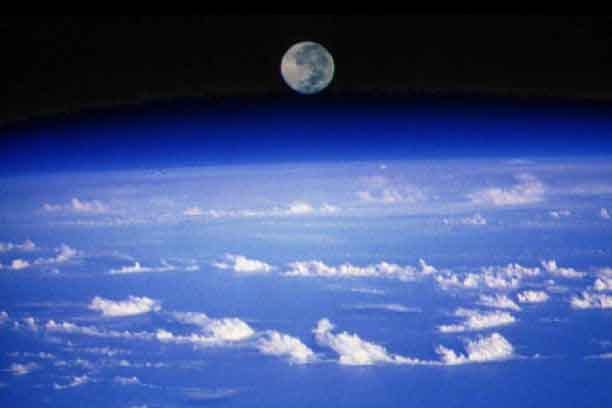
Average Earth-Moon distance: 380,000 km (240,000 miles)
All that is Earth has once been sky.
Down from the Sun of old she came.
— "The Meteorite," C. S. Lewis
Earth is the standard, of course.
There is really too much to say about Earth, simply because Earth is Here, wherever you are. As the main character reflects, while looking back at Earth from Mars in Out of the Silent Planet, by C. S. Lewis, "There everyone had lived and everything had happened."
We are used to thinking of Earth deities as goddesses, because the Greeks, Romans, and Norse had Earth goddesses (Gaea, Terra, Jord), as did many other cultures. But the Egyptians had an Earth-Father (Geb) rather than an Earth-Mother.
One interesting thing about Earth as a planet is that it was not considered a planet at all until Nicolas Copernicus published his heliocentric model of the universe, thereby kicking off the Scientific Revolution. Before that, only a few obscure philosophers (the Pythagorean Philolaos, Heraclides of Pontus, Aristarchos of Samos) entertained the idea that Earth was a planet. However, it was known since before Plato's time that Earth was a sphere; the idea that Medievals were flat-earthers is simply wrong.
I'm sure they shivered
When they finally touched the ground
And the giant leap so fragile
That it hardly made a sound.
— "Walk on the Moon," Great Big Sea
The Moon is tiny compared to Earth, but in addition to the usual figures, there's the interesting coincidence that it's the same apparent size in the sky as the Sun.
Because it has the same apparent size as the Sun, the Moon has often featured in our minds as a nocturnal version of the Sun, the Yin to its Yang. In fact, it may have helped inspire the idea of Yin and Yang.
The Moon is given to gods in some pantheons (Egyptian Khons, Norse Mani), goddesses in others (Roman Luna, Greek Selene). Months are named after the Moon, and in some calendars, such as the Jewish and Muslim, the phases of the Moon determine when months begin. Monday is the Moon's Day, and you can see "Luna" in the French Lundi and the Spanish Lunes or the Italian Lunedi. Alchemy associated silver with the Moon.
Western cultures often see a face in the patches on the Moon, the Man in the Moon. In the Orient, they often see a rabbit. I've never seen anything.
Ancient and Medieval philosophy saw the Moon as occupying the frontier between the sphere of the changeable Earth and the immutable Heavens. That, they supposed, was why its globe was blotched, not perfect.
The Moon figures heavily in science fiction, of course. The story I regard as the very first science fiction story, Somnium by the astronomer Johannes Kepler, is about a voyage to the Moon and how the sky would appear there. In Kepler's story, the rims of craters are the walls of lunar cities. Kepler's hero was taken to the Moon by a demon, but that doesn't make the story fantasy. In Kepler's time, demons were considered a deadly reality by mainstream thought, and his own mother was tried as a witch. (She was found innocent.)
That the Moon was not a perfect sphere, but had mountains, was one of Galileo's big discoveries. The astronomer Riccioli named the maria in the 1600s. Craters are traditionally named after astronomers.
We have sent a great many probes to the Moon, besides going there ourselves. Recent ones include the LCROSS probe that discovered ice at the Moon's poles and the twin GRAIL probes that have just recently entered lunar orbit.
On to Mars
Back to Venus
Return to Gallery of Planets
Return to Introduction to Essays
Return to Wind Off the Hilltop
Copyright © Earl Wajenberg, 2012